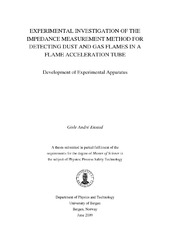Experimental Investigation of the Impedance Measurement Method for Detecting Dust and Gas Flames in a Flame Acceleration Tube. Development of Experimental Apparatus
Master thesis
Permanent lenke
https://hdl.handle.net/1956/3546Utgivelsesdato
2009-06-02Metadata
Vis full innførselSamlinger
Sammendrag
This master thesis describes an impedance measurement device built for investigating flame propagation in a Flame Acceleration Tube, FAT. This tube is 3.6 m long, and has been instrumented with thermocouples, pressure sensors and optical measurement probes in addition to the impedance probe. A control and data acquisition system built around a NI CAD 6259 card were developed and used during the experiments. The impedance is measured by finding damping and resonance coil and an unknown capacitor/impedance. The methodology gave satisfactory results during initial testing in a 20 litre vessel. However, problems with implementation in the FAT limited the qualitative value of the impedance measurements to basic flame arrival information. Experiments with lean fuel-air mixtures gave weaker readings of the flame, making some of the measurements uncertain. Kalvatn (2009) describes optical measurements of the same experiments. A tailor made probe has been developed. The probe contains both the optical and impedance based measurement techniques. This allows simultaneous measurements in the same cross sectional of the flame. The experiments were also filmed with a high speed camera. Results obtained with the methods and analyses of the video are compared. In general the video and optical measurements tend to detect the flame before the impedance measurements. Closed vessel experiments were performed in the FAT with both gas and dust. Three concentrations of propane were tested: 3.0%, 4.5% and 6.0%; as well as two nominal dust concentrations: 250 and 500 g/m3. The dust used were maize starch. The gas explosions produced much higher flame speeds than the dust explosions. The main drawback of the impedance measurements found is the time resolution. This problem is not easily solved if both the resistance and capacitance of the flame is of interest. However, if one can manage without separating out resistance and capacitance information the principle could offer very high time resolution. The experiments in the 20 litre vessel show that the combined impedance is possible to measure.
Utgiver
The University of BergenOpphavsrett
The authorCopyright the author. All rights reserved
